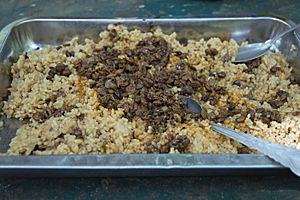Sumbala facts for kids
Sumbala or soumbala is a special condiment widely used in West Africa. A condiment is something you add to food to give it more flavor, like ketchup or mustard. Sumbala is made from seeds that have been fermented. This means tiny living things, like good bacteria, change the seeds over several days.
Traditionally, sumbala is made by women using seeds from the néré tree, also known as the African locust bean tree (its scientific name is Parkia biglobosa). Sometimes, other seeds are used, like those from the Prosopis africana tree. More and more often, people are using soybeans to make sumbala because there aren't always enough néré seeds. Sumbala is a bit like miso paste, which is a fermented food from Japan.
Contents
How Sumbala Is Made
Making sumbala takes several days. It's a careful process that usually involves these steps:
- First, the seeds are boiled.
- Then, they are cleaned very well.
- After cleaning, the seeds are packed away to ferment. This fermentation process is what gives sumbala its strong, unique smell.
- Sometimes, salt is added to the finished sumbala. This helps it last longer and stay fresh for many months.
What Sumbala Looks Like
Sumbala is usually sold in small balls or flat patties. The best quality sumbala can be stored for several months without going bad. It's a very common ingredient in traditional West African cuisine.
Why Sumbala Is Important
Sumbala is not just tasty; it's also very good for you! It has lots of proteins, which help your body grow and repair itself. It also contains many different dietary minerals that your body needs to stay healthy.
In the past, sumbala faced competition from cheap stock cubes. These cubes are often used to add flavor to food, but they don't have the same healthy proteins and minerals that sumbala does. Luckily, in recent years, good quality sumbala is being made and sold more widely. This has helped it become popular again in everyday cooking across West Africa.
Different Names for Sumbala
Sumbala is known by many different names in the various languages spoken in West Africa. Here are some of them:
- In Manding languages, it's called sumbala, sunbala, sungala, or sumara. The name "Sumbala" (or "soumbala" in French) comes from these languages.
- In Hausa, it's known as dawadawa or daddawa.
- In Pulaar/Pular, it's called ojji.
- In Yoruba, it's called iru.
- In Serer, Saafi, and Wolof, it's called netetou.
- In Krio, it's kainda.
- In Susu, it's Kenda.
- In Zarma, it's doso mari.
- In Dagbanli, it's Kpalgu.
- In Mooré, it's Colgo.
- In Likpakpaln (also known as Konkomba language), it's tijun or tijon.



